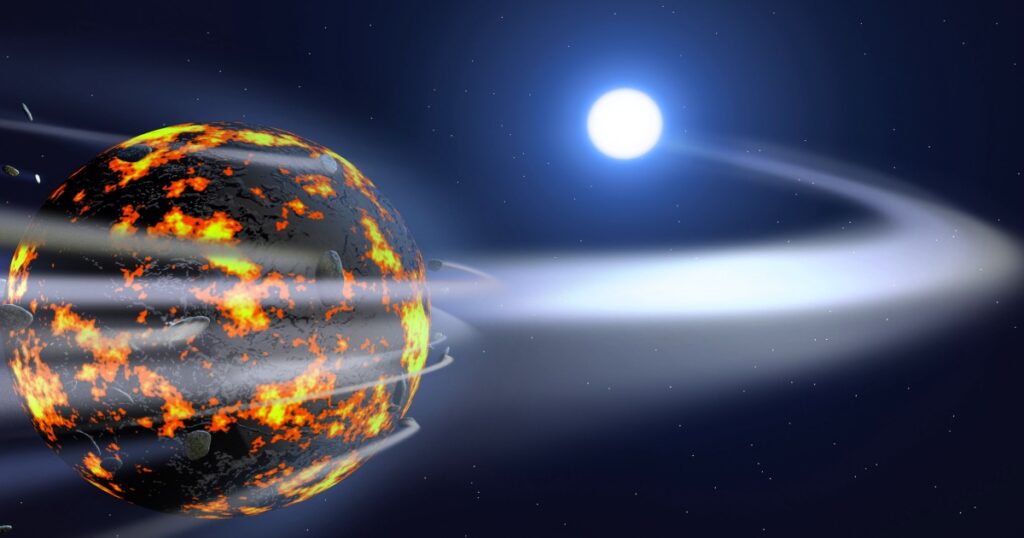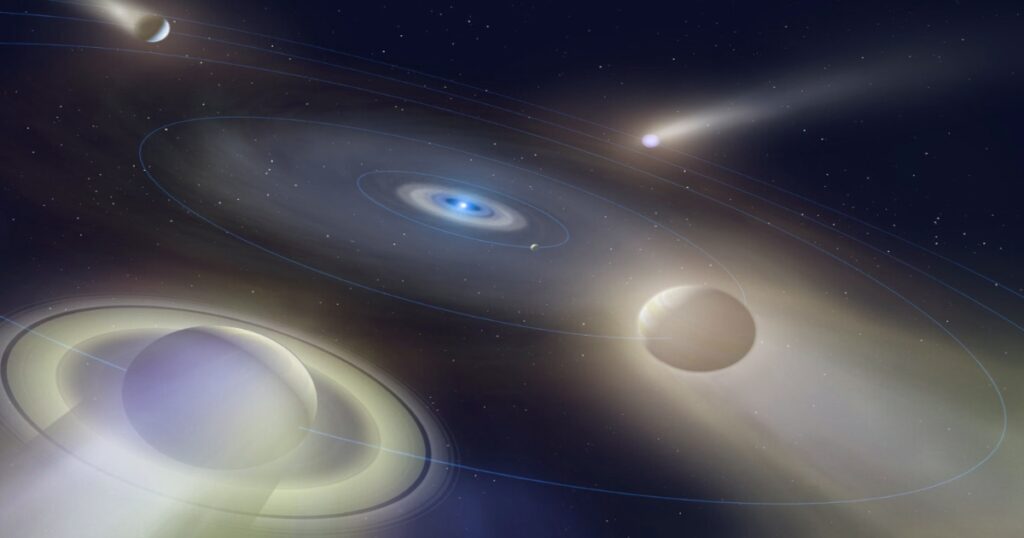What would happen to our solar system, the Earth, and the other planets when the Sun turns into a white dwarf is the question of everyone. We will briefly discuss the timeline and fate of our solar system and its planets during the end of the Sun’s life.
The Sun is a star formed around 4.6 billion years ago when a massive cloud of gas and dust collapsed due to gravity. It was a heated, whirling mass at this point. At this point in its life, our Sun is fusing hydrogen in its core to keep us warm.
The Sun is a middle-aged star at an estimated age of 4.6 billion years in the middle of its life cycle. It will take at least another 5 billion years, for it to transform into a white dwarf.

As the Sun’s hydrogen fuel will deplete, it will enter retirement. The Sun will start fusing helium, causing its core to heat up and expand. The outer layers will swell dramatically, turning the Sun into a red giant.
This expansion will likely engulf Mercury and Venus due to their close proximity. Earth’s fate is uncertain, it might also be scorched by the Sun’s increased heat or it might survive the Sun’s red giant phase. The outer planets (Mars, Jupiter, Saturn, Uranus, and Neptune) are far enough away to avoid being swallowed.
The radius of our Sun will eventually surpass the orbit of Earth. At this moment, the Sun will become less stable and lose mass. After the red giant phase, the Sun will expel its outer layers, forming a beautiful planetary nebula. The remaining core will collapse into a hot, dense white dwarf, a mere fraction of the Sun’s current size and much fainter.
What would happen to our solar system when the Sun turns into a white dwarf?

Our solar system will undergo a dramatic transformation when the Sun reaches the end of its life cycle and becomes a white dwarf.
What would happen to Mercury and Venus when the Sun turns into a white dwarf?
Mercury and Venus are close to the Sun and would likely be engulfed by the Sun during its red giant phase, even before the Sun turns into a white dwarf.
Mercury’s Fate: Due to Mercury’s extremely close proximity to the Sun (only about 58 million kilometers away), Mercury is almost certainly doomed. The red giant Sun will likely swallow Mercury whole.
Venus’ Fate: Venus, being farther out than Mercury (around 108 million kilometers), might escape complete engulfment. However, the Sun’s immense size and heat during the red giant phase will likely subject Venus to extreme temperatures that could vaporize its atmosphere and potentially melt its surface.
What would happen to Earth when the Sun turns into a white dwarf?
Initial Freeze (1-2 Billion Years): Without the Sun’s current level of warmth, Earth’s temperature will begin a gradual decline. Over 1-2 billion years, the average global temperature could plummet to around -80°C (-112°F). Most, if not all, life forms on Earth as we know them would likely cease to exist during this period.
The extreme cold would freeze oceans and dramatically alter the atmosphere, making it uninhabitable for current lifeforms.
Deep Freeze (Billions of Years): The temperature decline will continue, with Earth entering a deep freeze. The exact timeline is uncertain, but over billions of years, the planet could reach temperatures as low as -240°C (-400°F).
Complete Freeze: In theory, Earth could eventually reach a state where even the remaining atmosphere freezes solid, creating a completely frozen planet. However, the exact timeframe for this is beyond our ability to predict with certainty.
What would happen to the outer planets (Mars, Jupiter, Saturn, Uranus, and Neptune) when the Sun turns into a white dwarf?
The outer planets (Mars, Jupiter, Saturn, Uranus, and Neptune) are likely to remain in their orbits around the white dwarf sun due to gravity’s pull. However, they will become much colder and possibly experience significant atmospheric changes.
Reduced Radiation: The most significant impact will be the dramatic decrease in radiation received from the Sun. As a white dwarf, the Sun will provide a mere fraction of the light and warmth it does now.
Temperature Decline: This reduced radiation will cause the outer planets’ temperatures to plummet over time. However, their large size and distance from the Sun offer some protection. They might not experience a complete freeze like Earth (assuming it survives the red giant phase).
Atmospheric Changes: The colder temperatures could lead to the freezing of some gases in the outer planets’ atmospheres, potentially altering their compositions.
Moons: Moons orbiting the outer planets might also be affected. Those with potential liquid water oceans could see those oceans freeze solid.

Orbital Adjustments:
The planets will likely continue to orbit the white dwarf due to its remaining mass and gravitational pull. However, their orbits might undergo some adjustments depending on various factors. Planets closer to the Sun might experience a slight decrease in their orbital distance due to the white dwarf’s smaller size.
If there are multiple planets in the system, their gravitational interactions with each other could also influence their orbits around the white dwarf.
In some cases, a planet’s orbit might decay slowly over time due to tidal interactions with the white dwarf. This could lead to the planet eventually spiraling inwards towards the white dwarf, but this process would be extremely slow, taking billions of years.
Alternatively, depending on the specific circumstances, a planet’s orbit might actually drift slightly outwards after the Sun becomes a white dwarf.
Overview:
In short, during the retirement of the Sun, our solar system will be transformed completely. The Sun will engulf Mercury and Venus when it expands during its giant phase, it’s not certain whether Earth will survive or be Engulfed by the Sun too, but outer planets will survive the Sun’s red giant phase.
Then the Sun will turn into a white dwarf and because of lack of warmth, all the remaining planets in the solar system will be frozen.
Conclusion:
In 5 billion years, our Sun turns into a faint white dwarf. Inner planets like Mercury face fiery doom, while Earth freezes. Outer giants might survive but as icy, desolate worlds. The solar system, once vibrant, becomes a cold, dim echo of its former self.
